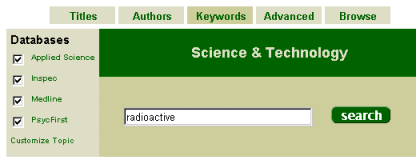Contents
Introduction
What is Cross-Database Searching Functionality
Recent Enhancements
More
About Cross-Database Searching Functionality
This topic provides an overview of cross-database searching functionality in WebZ by defining it and briefly showing how it is demonstrated in the Out of the Box Interface (OBI), version 1. Additionally, it points out recent enhancements made to the basic functionality that allow patrons to combine and de-duplicate their results.
What is Cross-Database Searching Functionality?
Simply defined, cross-database searching functionality is a software's capability to use a single search to look in many different databases for specific information. WebZ contains components that enable patrons to do this. When configured, WebZ cross-database functionality can produce one result set composed of records from multiple locations, which provides the widest choice of resources (papers, books, magazines, articles, and web sites) about a particular topic.
A Cross-Database Search
For example, as demonstrated in the OBI, version 1, a patron might conduct a cross-database search using the Science and Technology topic area and the keyword "radioactive."
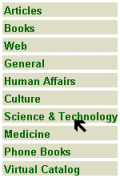 |
The Science and Technology topic area is composed of four databases: Applied Science, Inspec, Medline, and PsychFirst. |
Results
The
results would look similar to the following:
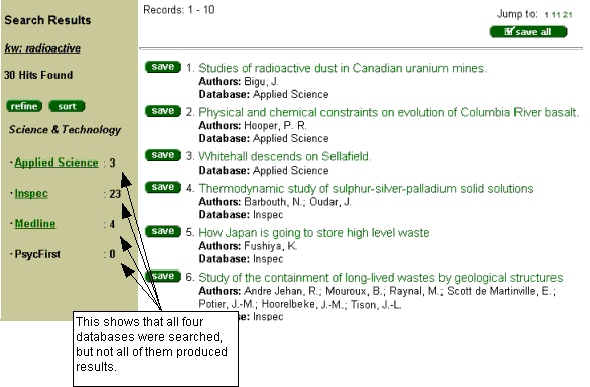
The results summary frame shows that WebZ searched for the keyword "radioactive" from all four databases.
Recent
Enhancements
Beginning with SiteSearch 4.1.0, the basic cross-database searching functionality
in WebZ has been enhanced to include:
These two functions have been added to the basic WebZ cross-database functionality to help patrons organize and view the records that they retrieve from multiple databases using the WebZ interface.
What
is Combined Result Set Functionality?
When configured, combined result set functionality causes a patron's cross-database search to generate a single contiguous result set that can be intermingled or sorted, depending on how the patron wants to view it.
Combined Results (Unsorted)
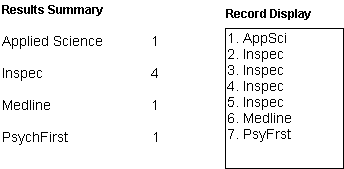
For example,
you can view combined results in the OBI, version 1 by conducting a search
using any topic area, like Science and Technology. Your initial results
would look similar to the following:
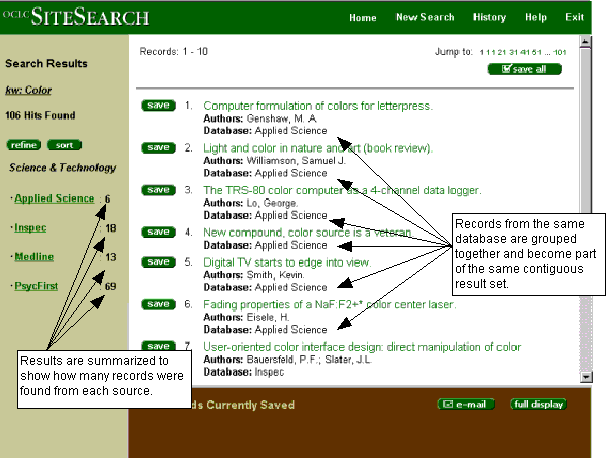
Within the WebZ software, search results from multiple databases are combined, making it possible for a patron to view a single set as opposed to navigating one for each database separately. And although results are combined, each record retains its identification and association with its source.
Combined and Sorted
Results
A combined result set can be sorted to change the order in which members are displayed in the WebZ interface.
The original number of hits is retained, but records from the various databases are displayed in a different order because they have been reorganized according to sort criteria such as author, title, or date.

The following result set from the OBI, version 1 demonstrates how a combined
and sorted result set can be displayed in the WebZ interface.

| Note: |
As with members 17 and 18 in the above result set, some records from the same database may appear next to each other, depending on the sort criteria that was used to reorder them. |
What
is Z39.50 Duplication Detection Service?
The Z39.50 Duplicate Detection Service is a standard that, when implemented in the WebZ interface, allows patrons to identify the same records from different databases within a combined result set.
De-duplicated Results
The following
example shows de-duplicated results retrieved from databases in the OBI,
version 1 using the Virtual Catalog topic area and the keywords "UNIX
network programming".
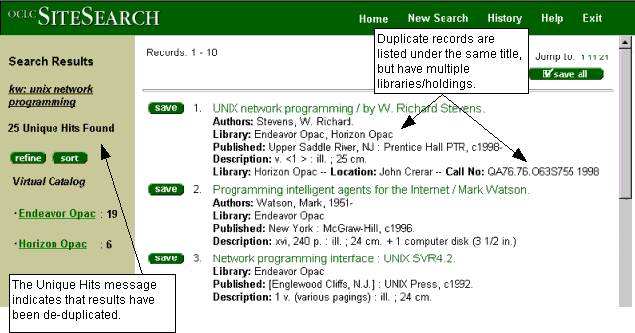
During a cross database
search, duplicate keys are extracted from records in the database result
sets. These keys are then sorted in ASCII order and duplicates are detected
among them using a class that implements the IDbSortKey
Java interface class. The sorted result set, made up of representative
record numbers and their duplicate record numbers, is stored in ZBase.
During the subsequent display of the search results, each representative
record appears as one title with holdings listed underneath it.
| Note: |
Not all database ini files must have the Z39.50 duplication detection service configured inside of them. For some databases, you may want this service and, for others, you may not. For example in the OBI, version 1, only those databases grouped under the Virtual Catalog topic area are configured for de-duplication. |
More About Cross-Database Searching Functionality
The following topics contain more information about cross-database searching functionality in WebZ:
|
Topic |
Description of Topic |
|
This topic covers the configuration of the central component of cross-database searching functionality that allows patrons to combine their results from multiple databases. Examples from the OBI, version 1 are used to show how basic cross-database functionality affects the display of search results. |
|
| Configuring Combined Result Set Functionality | How to configure the WebZ interface for combined result set functionality is covered under this topic. |
| Configuring Z39.50 Duplicate Detection Service | This topic identifies the constructs and parameters that must be defined and set to enable the Z39.50 duplicate detection service for your interface. |
| Selectively De-Duplicating Results | This topic reveals the option for selectively de-duplicating results by including the widget, dedup and its value "true" on the HTML page. How this widget works with the parameter, AutomaticDedupOnEverySearch is also discussed. |
See Also
